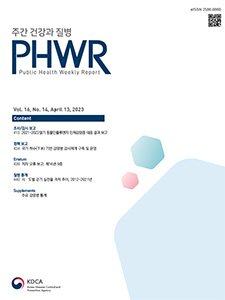Current Issue
Vol.16 No.14, April 13, 2023
-
Surveillance Reports 2023-04-13
 0
0
 747
747
 95
95
Preventive Responses to Avian Influenza Infection in Human in the Republic of Korea, 2021–2022
U Jin Cho, Sangeun Lee, Su-Yeon Lee, Hyungmin Lee*
Public Health Weekly Report 2023; 16(14): 413-423 https://doi.org/10.56786/PHWR.2023.16.14.1 Abstract
AbstractAvian influenza (AI) in humans is an acute respiratory infection caused by direct exposure to birds infected with AI viruses, such as H5N1, H7N7, and H7N9, or to contaminated environments. During 2021–2022, although no domestic AI cases in humans were confirmed, 47 cases of the highly pathogenic AI virus H5N1 were detected in poultry from seven cities or provinces nationwide. Furthermore, 148 cases were detected from samples of wild bird feces and carcasses from 12 cities or provinces and 48 cities or counties. When a highly pathogenic AI virus epidemic is expected in birds such as poultry, the Korea Disease Control and Prevention Agency (KDCA) establishes a cooperative system between local governments and related organizations to prevent the occurrence and spread of AI in humans. This is done by forming a countermeasure group and a surveillance system through preventive measures and on-site inspections. The surveillance system was particularly strengthened for farm workers or slaughter personnel, who are considered high-risk groups for AI, and preventive measures of seasonal influenza vaccination and antiviral drug administration were implemented. On-site inspections were conducted for slaughter personnel, who were instructed to wear personal protective equipment, and to classify the protected areas within the site. During the 2021–2022 season, 4,062 people (including farm workers, culling personnel, and hunters), in whom the highly pathogenic AI virus H5N1 was detected, were classified as a high-risk group for AI and managed accordingly. Although one patient was suspected of having AI, the test result was negative. No cases of AI in humans were reported. By describing the response process adopted by and results of the KDCA for the prevention of domestic AI in humans in 2021–2022, this report aims to provide a basis for establishing policies that are more effective in the prevention and management of AI in humans in the future.
-
Policy Notes 2023-04-13
 4
4
 1197
1197
 328
328
Establishment and Operation of National Wastewater-based Surveillance System on Infectious Diseases
Jinhwa Jang, Shin Young Park, Seong-Sun Kim, Ahra Kim, You-Jung Choi, Seo Hyun Kim, Aeri Kang, Sangwon Lee, Donghyok Kwon
Public Health Weekly Report 2023; 16(14): 424-438 https://doi.org/10.56786/PHWR.2023.16.14.2 Abstract
AbstractBecause of the COVID-19 pandemic, wastewater-based surveillance has garnered extensive attention in many countries, including the United States and those in Europe, by pre-emptively monitoring and responding to infectious diseases in the community. Additionally, it is actively used in national infectious disease monitoring policies. From 2021, the Korea Disease Control and Prevention Agency conducted a pilot project to prove the effectiveness of wastewater-based surveillance system in the Republic of Korea and laid the foundation to introduce a national wastewater-based surveillance system. In 2023, KOrea WAstewater Surveillance (KOWAS) project is being conducted in cooperation with 17 cities or provinces and 18 Institute of Health and Environment Researches. Henceforth, we will expand the scope of monitoring infectious diseases by cooperating with related ministries and prepare the crisis response for a potential pandemic by upgrading experimental techniques.
-
QuickStats 2023-04-13
 0
0
 468
468
 157
157
Trends in the Prevalence Gap in Walking Between Cities or Provinces, During 2012–2021
Public Health Weekly Report 2023; 16(14): 440-441 https://doi.org/10.56786/PHWR.2023.16.14.4

pp. 1433~1461
Most Keyword
?
What is Most Keyword?
- It is the most frequently used keyword in articles in this journal for the past two years.
Most Read
-
Waterborne and Foodborne Disease Outbreaks in the Republic of Korea, 2023
Myung-Jae Hwang, So Yeon Park, Hyungjun Kim, Se Jeong Yang, Sungchan Yang, Jin Seon Yang
Public Health Weekly Report 2025;18: 17-32 https://doi.org/10.56786/PHWR.2025.18.1.2 -
Implementation Plan for the Coronavirus Disease 2019 Vaccination for the 2024–2025 Season: Recommendations of the 6th Expert Committee on Immunization Practices
Hyewook Hwang, Wookeon Lee, Seohyeon Ahn, Young-Sook Choi, Seunghyun Lewis Kwon, Dongwoo Lee, Eun Hwa Choi, SokGoo Lee
Public Health Weekly Report 2025;18: 90-102 https://doi.org/10.56786/PHWR.2025.18.2.3
Editorial Office
+82-43-719-7569





 Full Text
Full Text Cite
Cite


